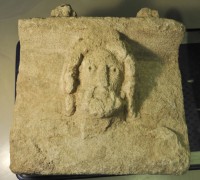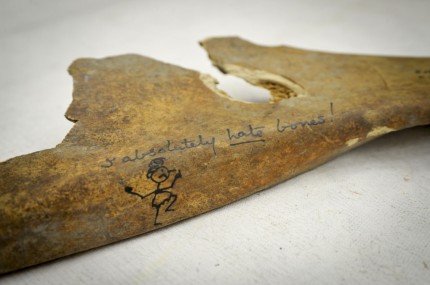 A limestone head of Jupiter unearthed at the Earith quarry near Colne Fen in Cambridgeshire, eastern England, has been donated to Cambridge University’s Museum of Archaeology and Anthropology. The sculpture dates to between the 2nd and 4th centuries A.D. and was discovered during 10 years of excavations (1997 – 2007) done by the Cambridge Archaeological Unit. It was donated to the museum by Hanson Aggregates, the owners of the quarry, and will go on display starting December 10th.
A limestone head of Jupiter unearthed at the Earith quarry near Colne Fen in Cambridgeshire, eastern England, has been donated to Cambridge University’s Museum of Archaeology and Anthropology. The sculpture dates to between the 2nd and 4th centuries A.D. and was discovered during 10 years of excavations (1997 – 2007) done by the Cambridge Archaeological Unit. It was donated to the museum by Hanson Aggregates, the owners of the quarry, and will go on display starting December 10th.
The sculpture’s rough appearance belies its historical significance. It is considered one of the finest Roman sculptures ever discovered in East Anglia.
Imogen Gunn, 33, collections manager for archaeology at the museum, said: “There’s a relatively small corpus of Roman sculpture from this area and this is definitely one of the best.
“And it’s always nice to be able to display things that are found locally – it always grabs people.”
Carved out of non-local limestone from Upwell in Norfolk, this Jupiter was once part of a larger monument. You can see a pair of paws perched above the cornice. Experts believe there was a lion, griffin or sphinx there once, but extensive excavation of the find site recovered no further fragments of the piece that might illuminate its full scope. That suggests the Jupiter section was brought to the area after it had already been separated from the rest of the monument.
Even as a fragment it would have been an expensive piece. It was probably reused as a funerary monument at The Camp Ground, telegraphing the wealth and importance of the deceased. Skeletal remains were discovered close by, but there’s no way of knowing if they were associated with the Earith Jupiter.
It was discovered at a site called The Camp Ground, in Roman times an inland port on the Car Dyke canal system with a settlement of 50 to 200 people on the edge of the marshy Fens. This was a large village for a Fenland community, probably a market center where people from neighboring farms came to sell, buy and trade their produce and stock. Because the canal system gave them access to the rest of the country and, via its link to the sea, lands foreign as well, a Norfolk limestone carving could easily, albeit not cheaply, have made its way to Earith over water.
On an unrelated note, museum volunteers made an amusing discovery while going through a collection of more than 1,000 animal bones found in a fish pond in the nearby town of St Neots in 1961. One of the bones, a bovine shoulder blade dating to the 16th century, had “I absolutely hate bones!” scribbled on it in marker along with an irate stick figure with a beehive hairdo and a skirt stamping her feet and making a hand gesture that looks distinctly like flipping the bird.

Ms Gunn said: “We have more than 1,000 bones from this dig. They would all have to be washed and marked with a site number and site code. There’s quite a lot of admin. You can see how that would start to get very boring. I’ve certainly felt that way, but I’ve never scribbled it on to a bone!” […]
Ms Gunn added: “This is now the most interesting thing about these bones. It adds to their story.”
:giggle:
And who could blame her, indeed? – ANIMAL bones? Endless checking to see what was being eaten. She never thought her annotation would itself become history. Good on her! 🙂